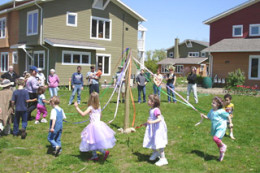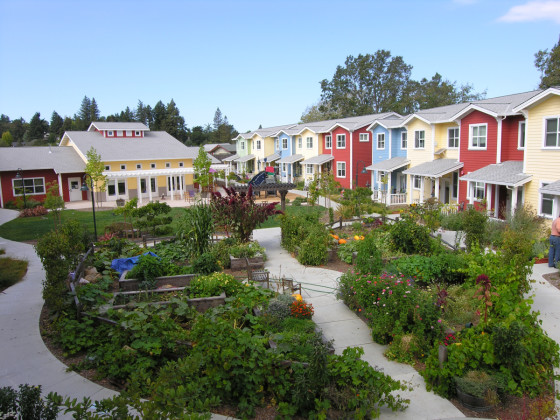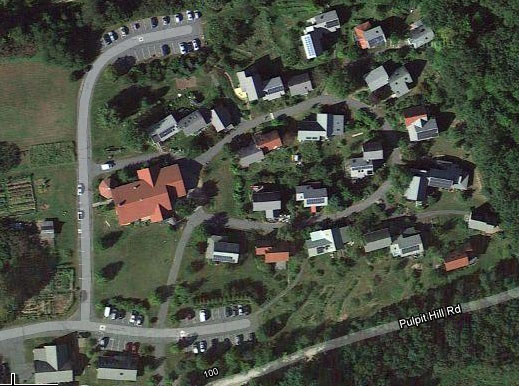Cohousing: An Ancient Idea Whose Time has Come - Future Generations
| Cohousing: An Ancient Idea Whose Time Has Come by Marian Van Court | |
This article appeared in Counter-Currents Publishing | |
In 1516, Sir Thomas More published his now-famous work, Utopia. One of his recommendations was that housing be constructed for groups of about 30 families in order to create small villages which share common facilities, dinners, and child care. This idea has recently been expanded considerably and put into practice in what has come to be called bofaellsskaber in continental Europe, and “cohousing” in the English-speaking world. Cohousing communities first appeared in Denmark in the late 1960s, and the idea spread to a number of other European countries, as well as the United States and Canada. Today in Europe, there are many hundreds of cohousing communities, and hundreds more in North America. |
|
Cohousing came into existence because people had become dissatisfied with the isolation of the typical suburban house or urban apartment, but they wanted to avoid the opposite extreme of communal living. They wanted privacy, but not alienation and loneliness. They wanted to be part of a community, but to retain their independence and their right not to participate. They wanted a safe, healthy, stimulating environment in which to raise children. One couple explained what motivated them to search for an alternative form of housing: Several years ago, as a young married couple, we began to think about where we were going to raise our children. What kind of setting would allow us to best combine our professional careers with child rearing? Already our lives were hectic. Often we would come home from work exhausted and hungry, only to find the refrigerator empty. Between our jobs and housekeeping, where would we find the time to spend with our kids? Relatives lived in distant cities, and even our friends lived across town. Just to get together for coffee we had to make arrangements two weeks in advance. Most young parents we knew seemed to spend most of their time shuttling their children to and from day care and playmates' homes, leaving little opportunity for anything else.r(MacCamant, Katherine, and Durrett, Charles (1988) Cohousing: A Contemporary Approach to Housing Ourselves, Ten Speed Press, California, p. 9.) What is Cohousing?The Danish word for cohousing, bofaellsskaber, translates eliving communities.e When Katherine McCamant and Charles Durrett wrote Cohousing: A Contemporary Approach to Housing Ourselves in 1988, they coined the English term ecohousing,e short for ecollaborative housing.e In a nutshell, cohousing is that which is organized in such a way as to create a natural community, much like the villages in which our ancestors lived for thousands of years. There are many variations on the cohousing theme. One cohousing venture was constructed inside an abandoned iron foundry, another was created in a high-rise apartment building. In one Toronto neighborhood, six families tore down their backyard fences and began sharing gardening equipment, buying in bulk, and eating dinner together several nights each week. Some cohousing communities have as few as 4 families, some as many as 80 (although the latter is subdivided into smaller groups). However, there are several essential elements which most cohousing communities have in common:
Although some cohousing groups modify existing structures, most embark on the more ambitious journey of building their communities from scratch. An individual or couple usually begins the process by placing an advertisement in the local newspaper or on the internet announcing their intention, asking like-minded people to contact them. After a series of meetings and considerable attrition, the group enters into in a loose-knit partnership and begins looking for a site upon which to build. Next they consult with a developer and an architect, with whom they work especially closely so they can build homes to fit each family's needs. From start to moving in, it takes a minimum of 2 years, sometimes as many as 4 or 5. Most cohousing is situated on the outskirts of a metropolitan area where many of the residents work. One typical arrangement is clusters of 2-story townhouses constructed in an oval shape surrounding a courtyard, along with one large, collectively-owned building at the end — the common house — used for dining and other group activities. The complex provides homes for 25 families of various compositions — couples with children, single parents with children, elderly couples, and singles. Houses may vary from one to four bedrooms. Each house is designed to be self-sufficient, and each kitchen is fully furnished. The front door opens into the courtyard with a semi-private yard for each household, and the back door opens to the outside to a private yard, and then the parking lot. This arrangement creates a village atmosphere where, in the course of ordinary, every-day activities, residents naturally interact and get to know one another. The Common HouseThe common house is the hub of social activity, where people can chat with neighbors, play indoor sports, and, most importantly, eat dinner. The evening meal is the main collective endeavor. Most cohousing communities serve dinner in the common house every night to the majority of residents. There are very substantial practical advantages of communal dinners over individually-prepared dinners, both in terms of time and money. Buying food in bulk is much cheaper, and one big effort spent preparing a communal dinner once a month for everyone is far less trouble than each family shopping, cooking, serving, and cleaning up independently each night. Two adults and two children may work together for several hours once a month to prepare a meal for everyone, and clean up afterwards. This entitles them to inexpensive, work-free dinners for the entire rest of the month. eI don't have to cook all those other nights,e one woman resident exclaimed cheerfully. eI can just waltz in there at 6 p.m. to a homemade dinner!e Almost all cohousing communities chose to include the following basic features in their common house, in order of priority:
Many cohousing communities also include storage areas, a laundry room, an adult lounge area, guest rooms for visiting friends and family members, office spaces, and other special-use spaces in the common house. Cohousing communities in Scandinavia often have glass-covered pedestrian streets or courtyards, which can be a blessing during their frigid winters. Practical MattersFinancially, owning a house in a co-housing community is like owning a condominium, where each household owns its own home, plus a share of the common facilities. In Europe, existing cohousing complexes are highly prized because buyers receive the benefits without all the developmental work involved in finding a site and building on it. Attempts are made to standardize as much as possible during the building phase — not customize — to keep costs down. Turnover in cohousing complexes is less than in conventional housing, and appreciation is considerable greater, as they're considered desirable places to live. ChildrenIn conventional housing, parents especially tend to feel isolated and stressed. If a couple decides to go out to a movie, for example, or if a wife wants to go shopping, what was formerly a simple act suddenly becomes a major undertaking when small children are involved, requiring finding a babysitter, picking her up, paying her, and driving her home again. Usually this must be planned well ahead of time in order to work smoothly, so there's little opportunity for spontaneity. In contrast, the social network which naturally develops in cohousing enables parents to take time away from their children on the spur of the moment. As one resident explained, eWhen you have children, you lose some of your freedom. To move into cohousing is to regain it.e Potential babysitters are always around. Children easily find playmates. The courtyard makes a safe haven for toddlers where mothers can keep an eye on them. Crime is virtually non-existent because everyone knows his neighbors, and a stranger will be spotted immediately. Cars are parked safely outside, on the periphery of the complex. Another resident explained it thus: If I had to chose one word to describe what cohousing meant to me, it would be security — in the emotional sense that I know there are people that I can depend on, people I can call for help. When I couldn't make it home the other night, I called a neighbor to ask him to feed the chickens. When I got home, I found that he had not only fed the chickens but also the rabbits, figuring I had forgotten about them. We never worry about finding a baby sitter because we know we can depend on one of the neighbors — and the kids are very comfortable staying with them. The older kids can just stay home because they have neighbors to call if they have any problems. (Ibid., p. 87) Children seem to thrive in this environment. Field trips become possible when a critical mass is reached such that if one or two participants drop out at the last minute, the outing doesn't fall through. As one cohousing resident put it: [T]here are favorable conditions for children here — socially, physically, and educationally. They are exposed to many more interests and stimulations than usual . . . They also have a strong sense of identity. They are not anonymousrhere; and like the children of any village, they know that there is a place they are recognized and have a sense of belonging. This enhances their self-confidence. Children who live in cohousing are usually ecan doe people because they learn from participating in so many kinds of activities, and receive recognition for their accomplishments. (Ibid., p. 87) Many families nowadays home-school their children, which can be a big burden on the mother, but it's made much easier by tackling the job collectively, as is day care for the younger children. Shared Facilities: More Stuff, Lower CostWhile few people would consider relinquishing private ownership of their houses, cars, or personal possessions, there will always be a myriad of impersonal items which people need occasionally which quite reasonably might be purchased collectively. Examples: guest rooms for visiting friends or family, soccer field, workshop, swimming pool, tree house, tennis court, exercise machines, and garden. In conventional housing, the family must either foot the bill for the entire thing, or go without. Cohousing makes it possible to own these sometimes-needed items collectively, at a fraction of the cost. A few cohousing communities even maintain a small store stocked with household items, cereal, toiletries, etc. The store is unattended, but all residents have a key so they can shop any time. They simply record the items they've bought, for which they're billed later. Residents appreciate the convenience of an on-site store, and benefit from the savings of buying in bulk. Who are These People?Virtually everyone in cohousing is on at least one committee, and most people attend at least some meetings. The alternative to attending meetings is to have no impact on how things are run, and to leave decisions to others who may — or may not — see things the same way. The point is that in this environment, unlike a typical suburban house or urban apartment, total lack of participation can have costs. New people assimilate quickly in cohousing, and become part of the community, which is an advantage in technologically advanced countries where more and more people work all day at the computer, never meeting anyone in the course of their workday, and where others move frequently to better jobs. People who chose cohousing are an interesting, self-selected bunch. They tend to be well-educated, with a broad range of interests, often active in local affairs such as politics or the school board. They also tend to be predominantly professionals, who often work at home, with higher than average incomes, of European descent, ranging from early thirties to retirement age, and politically somewhat Left of center. Efforts to increase ethnic diversity have not been successful. The authors of The Cohousing Handbook describe them as eexperienced and successful controllers,e accustomed to controlling the world around them, at least more so than the average person. When asked what most attracted them to cohousing, they reply that it offers safety and security; an ideal place for raising children; flexibility and choice in such things asrmeals and socializing; savings in terms of both money and time; and greater control of theirrlives. (Scott-Hansen, Kelly, and Scott-Hansen, Chris (2004) The Cohousing Handbook, New Society Publishers, p. 120) Cohousing is not for everyone. It probably wouldn't be a congenial environment for extreme introverts or people who dislike children. Personality clashes are inevitable in any group endeavor, and in small communities, they will have more impact than in larger ones, where it's easier for two people to simply avoid one another. In small communities, if the disagreement is serious, one party may decide to move out. Back to the FutureMedium-sized cohousing complexes (15-35 units) seem to work best. It's interesting that Sir Thomas More chose the figure of 30 families per village in Utopia, because it's not far from the median number of 25 which recent experience seems to have chosen as ideal (Ibid.,rp. 15). Evolutionary psychologists frequently talk about ethe environment of evolutionary adaptio Cohousing and EugenicsEugenicists are interested in cohousing because it makes parenthood easier and more enjoyable. Women who have children as a result of a conscious choice are, on average, much brighter and more responsible than women who have their children as a result of a series of eaccidents,e so eugenicists favor anything that makes motherhood easier. Moreover, high-IQ women often have fewer children than they would ideally like to have because of conflicts with career. Living in a cohousing community makes juggling career and motherhood easier and less stressful, so it could reasonably be expected to increase the fertility of this group. Many wives either want to work, or need to work. Few young couples can afford full-time nannies, but most want to have children. However, they don't want to become slaves to their children i they want to retain a good deal of their freedom. But is this even possible? In the Western world today, few couples have an on-call, 'round-the-clock baby-sitter living nearby, so it may not be possible. Cohousing provides couples the opportunity to have small, medium, or even large families while still retaining a good portion of their freedom. 21st-Century CohousingIn the future, cohousing ventures may increasingly be organized around one unifying principle i for example, all elderly residents, vegetarians, environmentalists, artists, musicians, writers, scientists, and those with specific religious or political philosophies. People who are committed to a religious or a political belief can be empowered by joining forces with others who have the same convictions. The value of such gatherings is already well-known, viz. universities, conferences, and churches. Inspiration doesn't occur in a vacuum, and having the opportunity to meet informally with colleagues on a regular, day-to-day basis could be ideal. When people get together who share the same beliefs and interests, it sparks imagination and fosters collaboration, and the kind of deep communication that makes life worthwhile. A unique and priceless efermente takes place that frequently results in original creative work. rConclusionBeyond sharing common facilities, dinners, and child care, cohousing has little else in common with Sir Thomas More's Utopia, and residents don't claim that life resembles a eutopiae in the more general sense of the word. Not surprisingly, however, cohousing communities bear a strong resemblance to traditional villages of the past. Cohousing offers major time, money, and convenience advantages over conventional 21st-century housing, particularly for parents and children, which probably account for its rather marked growth worldwide, despite the very considerable trouble and expense of starting such endeavors from scratch and seeing them through to completion. In addition to practical advantages, cohousing seems to have struck an emotional cord because it provides a more natural balance between autonomy and community. | |
- Finding Your Soul Mate with the Utmost Efficiency - Future Generations [Last Updated On: February 12th, 2021] [Originally Added On: February 12th, 2021]
- The Case for Eugenics in a Nutshell - Future Generations [Last Updated On: February 12th, 2021] [Originally Added On: February 12th, 2021]
- Raymond B. Cattell and The Fourth Inquisition[Last Updated On: February 12th, 2021] [Originally Added On: February 12th, 2021]
- The Consequences of Variable Intelligence - Book Review[Last Updated On: February 12th, 2021] [Originally Added On: February 12th, 2021]
- Glayde Whitney - Galton Conference[Last Updated On: February 12th, 2021] [Originally Added On: February 12th, 2021]
- 1963 - An Interesting Exchange of Ideas[Last Updated On: February 12th, 2021] [Originally Added On: February 12th, 2021]
- Eugenics: Economics for the Long Run [Last Updated On: February 12th, 2021] [Originally Added On: February 12th, 2021]
- The Concept of Heredity in the History of Western Culture, Part I [Last Updated On: February 13th, 2021] [Originally Added On: February 12th, 2021]
- Glayde Whitney - Book Review [Last Updated On: February 12th, 2021] [Originally Added On: February 12th, 2021]
- Bell Curve [Last Updated On: February 12th, 2021] [Originally Added On: February 12th, 2021]
- [Last Updated On: February 12th, 2021] [Originally Added On: February 12th, 2021]
- Evolution, Eugenics, and God's Will [Last Updated On: February 12th, 2021] [Originally Added On: February 12th, 2021]
- Adam, Eve, and Evolution [Last Updated On: February 13th, 2021] [Originally Added On: February 12th, 2021]
- Heretical Thoughts on Abortion & Eugenics - Future Generations [Last Updated On: February 12th, 2021] [Originally Added On: February 12th, 2021]
- Quotes We Just Happen to Like [Last Updated On: February 13th, 2021] [Originally Added On: February 12th, 2021]
- Eugenics, Questions and Answers [Last Updated On: February 13th, 2021] [Originally Added On: February 12th, 2021]













